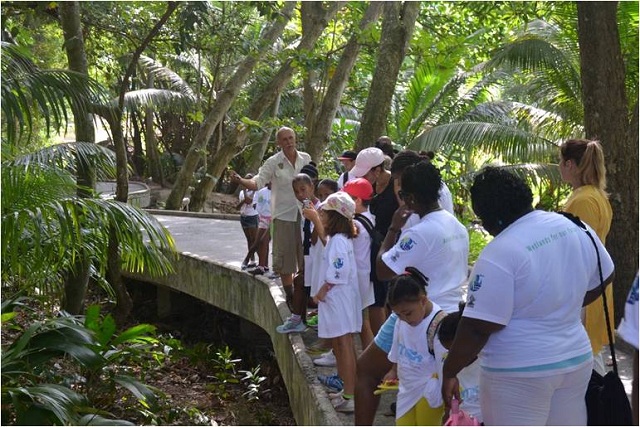Celebrating World Wetlands Day: for Seychelles, the future of wetland protection lies with hotels
Conservation |Author: Sharon Meriton-Jean and Hajira Amla | February 2, 2015, Monday @ 17:02| 9348 views
Getting to know you: the children in local communities around Constance Lemuria on Praslin Island, Seychelles, are connected to the mangrove wetlands surrounding the hotel because of the Lemuria's wetland programme (Isabelle Le Gac/Constance Lemuria Resort)
(Seychelles News Agency) - While playing golf on the 18-hole championship course of Constance Lemuria at Anse Kerlan on Praslin, the second most populated island of the Seychelles, it is common for players to find moorhens, a dark-coloured flightless bird with a gargling cry, in the ponds that surround the luxury resort.
Golf balls often end up in the mud where torti soupap, otherwise known as the Seychelles terrapin (Pelusios seychellensis) sunbathe alongside brownish, murky-looking water.
This wetland environment serves as a natural habitat for many other flora and fauna of the Indian Ocean archipelago, to the delight of the clients of the five star resort and guests.
“We have a lot of Germans and Swiss nationals, and they are very environmentally-conscious, so it is important to keep our environment as natural as possible,” says Adrian Alison, the landscape manager of Constance Lemuria Resort.
Alison also adds that the hotel has taken steps towards improving these areas by planting more mangroves.
"These swamps used to be covered with casuarina trees and coconut but these caused a lot of runoff during the rainy season which in turn affected our coral reefs, which is also an important sea turtle breeding ground.”
After rehabilitating and expanding the wetlands in 1999, Alison says there has been an increase in several species living in the area around the resort.
 |
| Children are regular visitors at Constance Lemuria where they learn more about the wetlands and steps that the management of the hotel on Praslin Island have taken to improve the ecosystem. (Isabelle Le Gac/Constance Lemuria Resort) Photo license: All Rights Reserved |
The Constance Lemuria Resort is one of several hotel establishments in the Seychelles archipelago which have been encouraged to adopt and endorse a management plan for wetlands in or around their property.
The sensitive mangrove wetlands reduce coastal erosion, intrusion of salt water and act as natural buffers against coastal erosion and extreme weather. A total of seven different species of mangrove trees can be seen growing naturally in Seychelles wetlands.
”Before a hotel is built in a wetland area, the wetlands unit in the Ministry of Environment encourages the proprietors to find alternative to their projects. Often they build above or their project size have to be reduced,” says wetlands coordinator at the Seychelles Department of Environment, Jean-Claude Labrosse, citing Hilton Seychelles Labriz on the island of Silhouette and Banyan Tree in the south of the main island of Mahé as other examples of resorts that have an active wetland management plan.
This year, to mark World Wetlands Day on Monday 2 February, the Ephelia resort partnered with the local Port Glaud community to launch their own management plan which would help to protect the wetlands that encompasses an area of more than 25 hectares.
“These initiatives are the only way we can get the private sector to be more involved in the protection of the environment. These programmes encourage them to organize activities for young people including educational activities as well as recreational activities,” Labrosse said.
The Port Glaud coastal wetland was the first area in Seychelles to be designated as an area with international importance under the Ramsar Convention. Two other areas, the Mare au Cochon wetlands in the hills of the southern of Mahé and the Aldabra atoll are also recognized under the convention signed in 1971.
To commemorate the internationally-celebrated day, several other activities were also organized in schools around the country to create awareness on the importance of wetland ecosystems and why they require special protection.
“With many low lying areas, Seychelles wetlands are still under pressure from developments and human interference such as illegal dumping and illegal constructions, but with threats such as climate change, the archipelago’s best chance of survival relies on the protection of its coastal areas especially its wetlands,” said Labrosse.
Back
